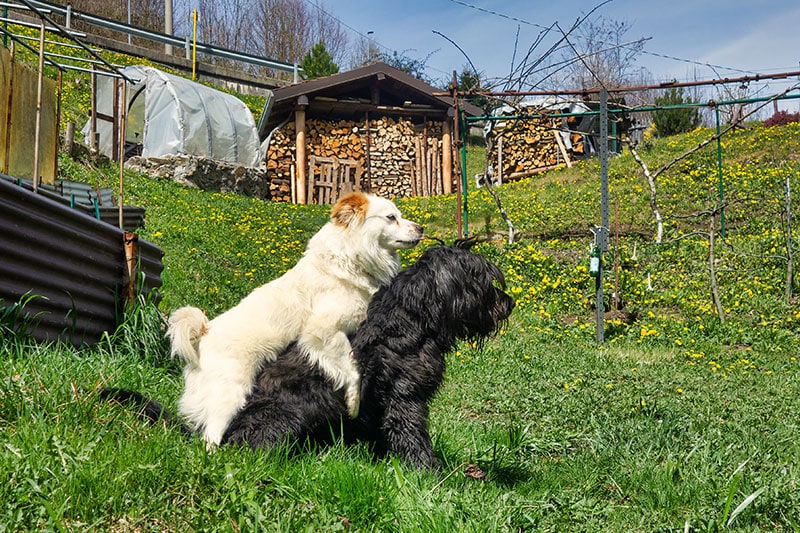If you’ve seen a dog mount another of the same sex, you may be wondering if dogs can be gay, lesbian, or bisexual. The science is clear; male and female dogs often engage in behavior such as mounting and thrusting with dogs of the same sex. Intact and neutered pets do it too! Same-sex sexual behavior is incredibly common, and scientists have documented over 1,500 species that regularly participate in various activities that can be classified as same-sex sexual behavior. However, scientists who study animal behavior caution against suggesting that animals are gay, queer, or bisexual, as these words have meanings that are only relevant within the context of human culture and society.

Why Do Dogs Mount and Thrust?
Mounting and thrusting are normal canine behaviors that have several causes. They can be sexually motivated, occur during play, and even result from anxiety. When sexually motivated, mounting and thrusting are often seen combined with body language and behavior that usually signal interest in reproductive activity.
These behaviors are also regular parts of canine play, but it’s uncommon for dogs to have erections when simply hanging out and enjoying the company of other pets at the dog park. Dogs sometimes mount and thrust when stressed, excited, or overstimulated particularly after meeting new people or dealing with anxiety-producing situations. Humping another dog of the same or different sex could also be a sign of dominance.

What Does Same-Sex Sexual Behavior Mean?
Same-sexual behavior could be used to describe various activities, from grooming to intimate touching, or even copulation. However, many of the behaviors often considered sexual in human terms, can have more than one purpose or motivation for dogs. Humans, for instance, have sex for reasons other than reproduction, such as pleasure and tension release. When it comes to animals, activities such as grooming, snuggling, and licking are frequently used to increase social bonds between participants. Some animals even engage in same-sex sexual behavior to show their dominance or relieve anxiety; others do it just for fun.
What Animals Engage in Same-Sex Sexual Behavior?
Male chimpanzees often engage in same-sex sexual behavior, and it is often used as a way to calm things down communities after serious fights. Female bonobos use it to create strong social bonds, and same-sex female partners are actually more common than male-on-male sex among bonobos! Same-sex sexual behavior has been extensively documented in rams — about 8 percent appear to prefer to have sex with other rams.
Laysan albatrosses, stunningly gorgeous seabirds, often engage in same-sex parenting, and about 30% of their nests are headed by two female birds. Male Humbolt penguins around the world have become famous for their chick-raising skills. Elmer and Lima, two penguins living in the Rosamond Gifford Zoo in New York, were given an egg to incubate. The baby hatched right on time, and Elmer and Lima continued to feed and care for their baby.
Male bottlenose dolphins are known to have sex for reasons other than reproduction, whether to establish dominance or simply for pleasure. They are often observed engaging in same-sex behaviors. These behaviors appear to also strengthen bonds between male pairs that often work together when seeking reproductive opportunities with female dolphins. Likewise, scientific studies have concluded that female Japanese macaques often have sex with each other simply because they enjoy it.

Are There Any Theories About How Same-Sex Sexual Behavior Developed?
Yes! However, research suggests that the better question may be, how did single-sex sexual behavior develop? The very first organisms on Earth were simple creatures. As animal lifeforms evolved, they became more and more complex, and likely all complex life forms evolved from hermaphrodite ancestors. While scientists can not know for sure, it seems to be a genetic mutation in the hermaphroditic genes that resulted in sexual differentiations of organisms affecting characteristics such as their size, smell, and shape. In that sense, same-sex sexual behavior has preceded male and female sexual behavior.
Why Is Same-Sex Sexual Behavior Difficult to Study?
Scientists often run into difficulty studying sexual behavior in animals because of time constraints and the difficulty of accurately identifying the sex of animals in the wild. While it’s often relatively easy to observe animals engaging in a particular activity, these moments only provide brief snapshots of that individual’s potential range of sexual behaviors.
Scholars also sometimes have trouble identifying whether an animal is male or female, particularly among species that don’t have sex-based characteristics such as size or other physical differences. Jonathan, a tortoise who lives in St. Helena Island, spent decades mating Frederica, who was assumed to be a female. During a medical procedure in 2017, veterinarians learned that Frederica was, in fact, male. The pair first started getting it on back in 1991. And just in case you’re wondering, Jonathan celebrated his 190th birthday in 2022 by snacking on a “salad cake.”

Final Thoughts
Dogs often engage in same-sex thrusting and mounting behavior. It’s relatively common and can be seen in male, female, intact, and neutered dogs! While scientists have widely documented same-sex sexual behavior in animals, many advise against using words such as gay, lesbian, and bisexual to discuss non-human behavior. Same-sex sexual behavior is quite prevalent and has been observed in birds, dogs, cats, insects, dolphins, and penguins. It has been reported in 1,500 species. Same-sex sexual behavior in animals ranges from parenting to intimate contact and is often used to strengthen social bonds, relieve stress, and even increase the chances of offspring survival.
See Also:
Featured Image Credit: yulana, Shutterstock



















